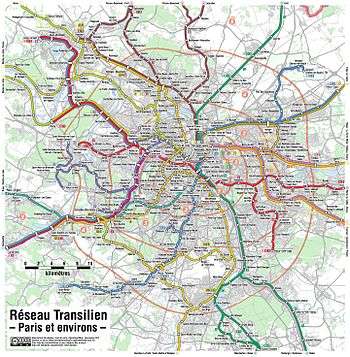Transilien



The Transilien (pronounced: [tʁɑ̃s.il.jɛ̃]) is the brand name of the suburban railway service of the SNCF-owned railway network operating within the Île-de-France région. "Transilien" is a derivative of Francilien, a term commonly used to describe the inhabitants of the Île-de-France.
Transilien trains depart from Paris' main railway and RER stations (although many city-centre RER stations are run by the RATP) and the western business district of La Défense. Transilien services transported 615 million passengers in 2004.
History
The first line to the suburbs of Paris was opened on the 26 August 1837. The route went from Paris-Saint-Lazare to Le Pecq. The railway link was thought of as key to the western suburbs. On 1 October 1972, the line was handed over to the RER, and commenced service as the RER's ligne A.
The Transilien today
The transilien is divided into six key entities, which are divided according to SNCF guidelines and are in no way related to the departmental boundaries. The lines are then divided into branches which, similarly to the RER, are given letters, although until 2005, these letters were unknown to the wider travelling public.
The six Transilien entities are:
- Transilien P, Paris Est
- Transilien H and K, Paris Nord
- Transilien J and L, Paris Saint-Lazare
- Transilien U, Paris La Défense
- Transilien N, Paris Montparnasse
- Transilien R, Paris Lyon
The system is slightly complicated, in that for each different entity, structures are very different. Key complications include:
- The power supplies
- The numbers of branches
- The lack of onward transportation beyond the termini
- Density of trains on the network
- The mix of traffic on the railway including express trains, freight trains, long distance trains, Transilien trains and RER traffic.
The importance of these glitches in the network are visible at times when SNCF staff go on strike or when serious technical problems occur on the network. Thousands of travellers arrive late for work, or when there are serious problems, decide not to go into work causing a huge financial burden for companies.
The extent of the lines means that concentric zoning is used. Trains bound for the outer zones are normally operated as express trains, meaning trains serve Paris termini then operate non-stop to the outer zones, meaning less travel time.
Rolling stock
The rolling stock used on the Transilien comes from a long evolution of the material in the suburbs. The following stock is used on the network:
On January 16, 2002, during a ceremony at the Gare de Paris-Est, the President of the SNCF Louis Gallois, the Prefect of the Ile-de-France Jean-Pierre Duport and the Regional Chair Jean-Paul Huchon, presented the new liveries of Transilien.
The design used for the rehabilitation and rejuvenation of the fleet was conducted by two outside agencies under contracts awarded in October 2000. RCP Design Global provided exterior design and interior signage, and Avant Première the interior. All vehicles received a new blue and gray Transilien livery with panels of color to highlight doors and internal characteristics. Everything was treated with a graffiti resistant coating to reduce the impact of vandalism. The trains are equipped with a new ergonomic design of seating with individual seats instead of the traditional banks. They are covered with vandal-resistant fabric in blue, yellow and red. Circulation and inter-car doors have been modified to improve the distribution of passengers in trains[1]
 Transilien upper room.
Transilien upper room. New livery of the Transilien.
New livery of the Transilien. Doors opened.
Doors opened. Doors closed.
Doors closed.
Transilien entities
"Paris Montparnasse" lines
The trains on this line operate from Gare Montparnasse along the following routes:
- Transilien N
- Paris Montparnasse - Mantes-la-Jolie via Plaisir-Grignon
- Paris Montparnasse - Houdan - Dreux (first stop Versailles-Chantiers, then Plaisir-Grignon and then all stations to Dreux)
- Paris Montparnasse - Rambouillet
"Paris Lyon" lines
The trains on this line operate from Gare de Lyon along the following routes:
- Transilien R
- Paris Lyon - Montereau via Moret-Veneux-les-Sablons
- Paris Lyon - Souppes-Château-Landon - Montargis
- Melun - Montereau via Héricy
"Paris Nord" lines
The trains on this line operate from Gare du Nord along the following routes:
- Transilien K
- Gare du Nord - Dammartin Juilly Saint-Mard - Crépy-en-Valois
- Transilien H
- Gare du Nord - Luzarches
- Gare du Nord - Persan-Beaumont via Montsoult-Maffliers (Eastern branch) or via Ermont-Eaubonne (Western Branch)
- Gare du Nord - Pontoise - Persan-Beaumont - Bruyères-sur-Oise - Creil
"Paris Est" lines
The trains on this line operate from Gare de l'Est along the following routes:
- Transilien P North
- Paris Est - Meaux
- Paris Est - Crouy-sur-Ourcq - La Ferté-Milon
- Paris Est - Nanteuil-Saâcy - Château-Thierry
- Paris Est - Esbly - Crécy-la-Chapelle
- Transilien P South
- Paris Est - Longueville - Provins
- Paris Est - Coulommiers
- Paris Est - La Ferté-Gaucher
"Paris Saint-Lazare" lines
The trains on this line operate from Gare Saint-Lazare along the following routes:
- Transilien J North
- Paris Saint-Lazare - Cormeilles-en-Parisis
- Paris Saint-Lazare - Pontoise
- Paris Saint-Lazare - Chars - Gisors
- Paris Saint-Lazare - Mantes-la-Jolie par Conflans
- Transilien J South
- Paris Saint-Lazare - Poissy - Mantes-la-Jolie
- Paris Saint-Lazare - Port-Villez - Vernon
- Paris Saint-Lazare - Bréval - Évreux (via Mantes-la Jolie)
- Transilien L North
- Paris Saint-Lazare - Cergy-le-Haut
- Transilien L South
- Paris Saint-Lazare - Saint-Cloud
- Paris Saint-Lazare - Versailles Rive Droite
- Paris Saint-Lazare - Saint-Nom-la-Bretèche
- Saint-Germain-en-Laye - Grande ceinture - Noisy-le-Roi
"La Défense - La Verrière" line
The trains on this line operate from La Défense station along the following route:
- Transilien U
- La Défense - La Verrière
See also
References
- ↑ Transilien stock updated. Railway Gazette, 03/2002.
